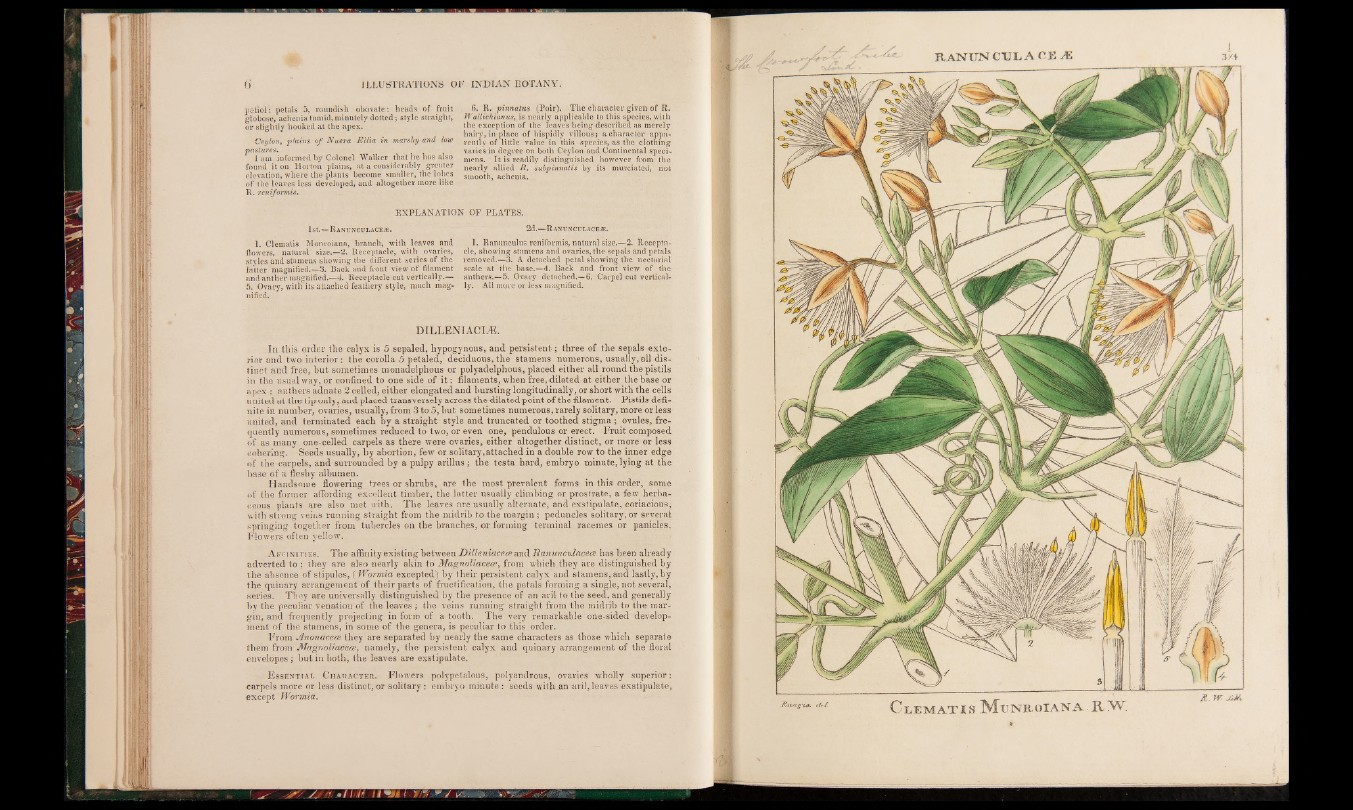
petiol: petals 5, roundish obovate: heads of fruit
globose, achenia tumid,minutely dotted; style straight,
or slightly hooked at the apex.
Ceylon, plains o f Nu era E llia in marshy and low
pastures.
I am informed by Colonel Walker that he has also
found it on Horton plains, at a considerably greater
elevation, where the plants become smaller, the lobes
of the leaves less developed, and altogether more like
R. reniformis.
6. R. pinnatus (Poir). The character given of R.
Wallichiamis,_is nearly applicable to this species, with
the exception of the leaves being described as merely
hairy, in place of hispidly villous; 'a character apparently
of little value in this species, as the clothing
varies in degree on both Ceylon and Continental specimens.
It is readily distinguished however from the
nearly allied R . subpinnatis by its muvciated, riot
smooth, achenia.
EXPLANATION OF PLATES.
1st.—Ranunculace«.
1. Clematis Munroiana, branch, with leaves and
flowers, natural size.—2. Receptacle, with ovaries,
styles and stamens showing the different series of the
latter magnified.—3. Back and front view of filament
and anther magnified.—4. Receptacle cut vertically.—
5. Ovary, with its attached feathery style, much magnified.
2d.—Ran u n cula ce® .
1. Ranunculus reniformis, natural size.—2. Receptacle,
showing stamens and ovaries, the sepals and petals
removed.—3. A detached petal showing the nec'tarial
scale at the base.—4. Back and front view of the
anthers.—5. Ovary detached.—6. Carpel cut vertically.
All more or-less magnified.
DILLENIACLE.
In this order the calyx is 5 sepaled, hypogynous, and persistent; three of the sepals exterior
and two interior : the corolla 5 petaled, deciduous, the stamens numerous, usually, all distinct
and free, but sometimes monadelphous or polyadelphous, placed either all round the pistils
in the usual way, or confined to one side of it: filaments, when free, dilated at either the base or
apex : anthers adnate 2 celled, either elongated and bursting longitudinally, or short with the cells
united at the tip only, and placed transversely across the dilated point of the filament. Pistils definite
in number, ovaries, usually, from 3 to 5, but sometimes numerous, rarely solitary, more or less
united, and terminated each by a straight-style and truncated or toothed stigma; ovules, frequently
numerous, sometimes reduced to two, or even one, pendulous or erect. Fruit composed
of as many one-celled carpels as there were ovaries, either altogether distinct, or more or less
cohering. Seeds usually, by abortion, few or solitary, attached in a double row to the inner edge
of the carpels, and surrounded by a pulpy arillus; the testa hard, embryo minute, lying at the
base of a fleshy albumen.
Handsome flowering trees or shrubs, are the most prevalent forms in this order, some
of the former affording excellent timber, the latter usually climbing or prostrate, a few herbaceous
plants are also met with. The leaves are usually alternate, and exstipulate, coriacious;
with strong veins running straight from the midrib to the margin; peduncles solitary, or several
springing together from tubercles on the branches, or forming terminal racemes or panicles.
Flowers often yellow.
A f f in it ie s. The affinity existing between Dilleniacp.ee and Ranunculacece has been already
adverted to ; they are also nearly akin to Magnoliacece, from which they are distinguished by
the absence of stipules, ( Wormia excepted) by their persistent calyx and stamens,-and lastly, by
the quinary arrangement of their parts of fructification, the petals forming a single, not several,
series. They are universally distinguished by the presence of an aril to the seed, and generally
by the peculiar venation of the leaves; the veins running straight from the midrib to the margin,
and frequently projecting in form of a tooth. The very remarkable one-sided development
of the stamens, in some of the genera, is peculiar to this order.
From Anonacece they are separated by nearly the same characters as those which separate
them from Magnoliacece, namely, the persistent calyx and quinary arrangement of the floral
envelopes; but in both, the leaves are exstipulate.
E ssential C haracter. Flowers polypetalous, polyandrous, ovaries wholly superior:
carpels more or less distinct, or solitary: embryo minute: seeds with an aril, leaves exstipulate,
except Wormia.